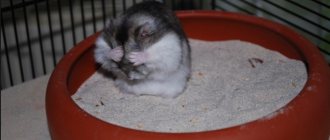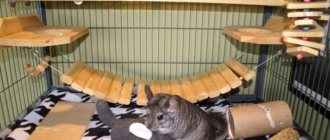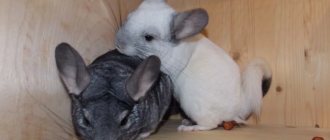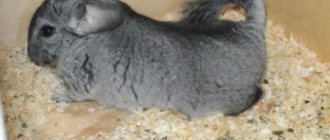In order to maintain the health, appearance and mood of the animal in good condition, constant care for this unique animal is necessary. Care consists not only of proper nutrition and providing the pet with a spacious home, but also of keeping the chinchilla’s dense, thick fur clean, helping the animal to bathe on time. This animal should be bathed in a special way, which is quite different from the usual bathing of cats or dogs.
Like any animal, a chinchilla needs to have its fur cleaned occasionally.
How chinchillas bathe in the sand
In the wild, chinchillas bathe in the volcanic sand of the Andean cordillera.
Sand acts as a soft abrasive and removes stuck-on dirt from the rodent's fur.
The second purpose of sand is to play the role of an absorbent so that the animal gets rid of excess moisture. As a result, conditions for the proliferation of bacteria and the appearance of parasites are suppressed.
Hygiene procedures are important for little furry. At home, these clean animals happily roll around in a bath of fine sand, periodically shaking off their luxurious coat.
The rodent spins around in the sand so energetically that small grains of sand fly around and as a result the cage becomes dusty. But this is not a reason to deprive your pet of a useful activity.
Chinchillas have small membranes in their ear canals that serve as a barrier against foreign objects entering during bathing.
How to bathe an animal
There is no need to bathe a chinchilla in the sand; it does it itself. The owner only needs to supply a suitable bowl of sand. Ordinary sand is not suitable; you need to buy high-quality and clean filler at a pet store. River sand may contain impurities that are unnecessary for the animal. The contents of the bath are changed regularly, preventing contamination with hair and boluses.
The animal really likes to swim. If he has no other entertainment, he will do it more often than necessary. As a result, the skin will be overdried, and this should not be allowed. The tray is not left in the cage for a long time because the rodent will start using the sand bath for the toilet. Hay, feed, filler, and wool go there. As a result, the sand becomes dangerous for swimming.
Features of sand procedures
The best time for swimming is evening. As evening approaches, the rodent is most active, and therefore sand cleaning will be more effective. You can take extra care of your chinchilla's fur if you add medical sulfur, crushed Fungistop or Nystatin to the filler - this is a good fungus prevention.
When a chinchilla bathes, a large amount of dust is generated.
Most likely, during the “bathing” process the room will be filled with dust. This is natural, because the animal spins in the sand, raising the smallest particles into the air. That's why the best place for this type of bathing is the bathroom. Or be prepared to wipe all surfaces in the room with a damp cloth and shake out dust from soft items.
As for sand, it can be reused. But for this it is necessary to remove debris from it. It is also recommended to add fresh material to the old one. The bath should be completely renewed every 10 procedures.
Remember: sand bathing for a chinchilla is as necessary as a comfortable cage and regular food.
What to do if your pet doesn't want to bathe
Two weeks after giving birth, the female is already showing the cubs by example how to bathe. In another week they will be able to bathe on their own.
There are situations when the breeder’s animal was happy to bathe, but does not want to go to a new place.
Measures to take:
- take from the breeder a tray where the smell of a rodent is preserved;
- place the container lower so that the animal does not get scared;
- leave the room while the animal is bathing;
- buy sand from another company;
Under no circumstances should a rodent be forced to remain in the bathhouse against its will. This can forever cement the negative connection between the bath and the owner in the pet’s mind.
According to the observations of breeders, a young chinchilla bathes in the sand with little desire; with age, the craving for hygienic procedures increases.
When your pet refuses to bathe, eats poorly, behaves lethargically and drowsily, you need to consult a veterinarian.
There are techniques that will help reinforce the chinchilla’s desire to swim in the sand:
- Say the word “bathe” with a gentle intonation when your pet enters the bath;
- After finishing the bath, treat him with a treat.
It will take very little time for the animal to understand the benefits of bathing and begin to do it when invited.
Answer: Itchy ears
Today I searched on the Internet for ear diseases in chinchillas. The only thing that is there is this: “As a result of severe pollution, inflammation of the external auditory canal can begin - otitis externa. Animals scratch their ears or rub their heads on the bottom of the cage. In severe cases, they keep their head tilted to the side. Brownish pus leaks from the ear canal, and in severe cases, this can lead to inflammation of the surrounding skin. The inflamed ear canal should be thoroughly cleaned with a cotton swab. However, under no circumstances should you use solvents containing alcohol, which are sold as so-called “ear cleaning solutions” and can further damage the epithelium of the ear canal. After thoroughly cleansing the ear canal, apply an ointment with fish oil and zinc using a cotton swab. After 48 hours, the ear canal is cleaned again and ointment with fish oil and zinc is applied.” I also read that ear mites do not occur in shinshas. That is, supposedly option 1 remains - that same otitis externa. But I couldn’t find anywhere where to get this ointment (with zinc and fish oil) and what to use to wipe it with (if you can’t use alcohol-containing solutions). Maybe someone knows what ointments this otitis media is treated with?
- 10.09.2007, 20:42
#6
Is it possible to bathe a chinchilla in water?
Chinchillas in the wild never bathe in water. There are good reasons why this cannot be done at home:
- The animal has a thick undercoat, and there are no sebaceous glands on the skin. Fur that is not greased immediately absorbs liquid and becomes heavy. Therefore, the rodent cannot stay afloat for long and avoids bodies of water.
- Wet wool no longer serves the function of protecting the rodent from cold and wind, and in the room from drafts. There is a high probability that the animal will get sick.
You should not bathe a chinchilla in water for the reason that the animal will be stressed, which will make it feel unhappy. When an animal's coat suddenly becomes unkempt, faded and matted, you need to show the animal to a veterinarian. The fur coat reflects the state of health.
Bathing suit
A bath for a chinchilla is a prerequisite for keeping it at home. If it is not there, the animal’s fur will become dirty, lumps will begin to form and an unpleasant odor will appear.
You can swim:
- Buy
- Do it yourself
Bathing suits are sold in almost every pet store or they can be ordered from online stores like Ozon. Their cost starts from 500 rubles. The bathing suit is a plastic container, which consists of two parts: a bottom and a lid. The lid should always be removable so that you can easily change the sand in it and completely disinfect it during general cleaning.
What characteristics should a swimsuit have:
- Closed top to prevent the chinchilla from throwing sand in different directions
- Opening lid to make it easy to clean the bathing suit and change the sand in it
- Safety. The hole should be large enough so that the chinchilla does not get stuck in it, and also that it does not have sharp edges.
To take sand, or rather dust baths, a chinchilla requires a special container - a bathing suit. If your pet bathes in an open container, sand will scatter not only throughout the cage, but also around it. Therefore, as a bathing suit, you need to choose dishes with high walls or use a container made of plastic or tin measuring 30x30x20 cm. A three-liter glass jar is also suitable for bathing purposes. Glass bathing suits are good because they make it convenient to watch your chinchilla taking a bath. In pet stores you can find various bathing suits made of plastic or ceramics (for example, a ceramic bathing suit with ears or a house-shaped design is convenient).
Whether or not to keep the bathing suit in a cage is up to you. It is best to store it next to the cage and transplant the animal there so that the sand is always clean. If you don’t have time to care for your pet and constantly change it into a bathing suit, then, of course, it is better to place it in a cage so that the chinchilla bathes itself when it needs it.
When and how to bathe a chinchilla in water
Bathing chinchillas in water is permissible if they are dirty in a substrate that is hazardous to health or in persistent and sticky mud. You should try to wash off the stained areas of the fur coat using a cotton swab dipped in warm water. Do not wash your chinchilla with scented shampoo. The animal may have allergies.
If a damp cotton swab does not solve the problem, proceed as follows:
- prepare two containers with warm water, 2-3 well-absorbent napkins and shampoo for rodents (hypoallergenic for children is possible);
- Stir a few drops of shampoo in one container;
- the pet is gently supported under the abdomen and washed until it becomes clean;
- rinse off the shampoo in the second container;
- the muzzle and ears cannot be immersed in water; they are wiped with a damp swab;
- stroking and slightly squeezing the pet, squeeze out the fur;
- Next, you need to dry the wool as quickly as possible by changing terry napkins.
If the animal responds well to the sound of a hair dryer, you can direct a stream of warm air at it. Another way is to put it in your bosom and warm it on your chest. This is done when a trusting relationship has been established between the pet and the person. All actions related to bathing and drying should be accompanied by quiet, gentle speech. The pet will be soothed by the owner's voice and the stress from contact with water will decrease.
If all these methods are unacceptable, the chinchilla can be placed on a warm (not hot) heating pad covered with a diaper. Until final drying, it is advisable to keep the pet in a carrier cage with the sides closed from drafts.
You can bathe a chinchilla only in a warm room at a temperature not lower than 23℃. You should not let the animal walk on the floor after the bath procedure.
Review of popular bathing mixtures
Both domestic and foreign manufacturers offer many varieties of ready-made sand mixtures for bathing chinchillas. Let's look at the most popular manufacturers of sand for bathing chinchillas.
- Benelux . The basis of this bathing mixture is zeolite; it is a well-known and trusted manufacturer. Although the price is not high, it is also difficult to call this sand budget.
- Lolopets . Composition: volcanic dust and crushed quartz. One of the advantages is the low price.
- Mr. Alex . Affordable sand for bathing chinchillas based on crushed quartz. The package also contains talc in a separate sachet, which must be added before bathing.
- Waka . Produced in Russia. Base: a mixture of volcanic sand with crushed quartz. A sachet of talcum powder is also included. Owners of chinchillas in reviews of this mixture strongly recommend that you carefully inspect it after purchase, since large particles may be encountered that can injure the animal. If such particles are found, they should be removed. As for the price, it is quite affordable.
- Little animals . Mixture from a Russian manufacturer. Chinchilla owners write in reviews that at a very affordable price, this mixture, which includes talc, magnesite and chlorite, is quite good. It perfectly cleans the animal's fur without harming it.
- Padovan . Sand from this manufacturer is recommended for use by owners of chinchillas whose animals are kept in rooms where the humidity is above average. Because this mixture, made on the basis of zeolite with the addition of a number of minerals, has excellent performance in terms of absorption and moisture retention.
- Vitacraft . Products of a famous German manufacturer of pet products. Composition: sepiolite and other minerals. The mixture is very popular due to its relatively low price and good consumer characteristics.
- Little One . Made from several minerals of volcanic origin. Chinchilla owners note that the main advantage is the almost perfect balance of components, which allows for the best possible cleaning of the animal’s fur. A very noticeable disadvantage is the high cost.
What to do if your chinchilla gets wet
The chinchilla should be protected from contact with water. If it falls into a bucket or bowl of water, it must be removed from there immediately. She might drown.
Next, you need to take measures to dry the animal as soon as possible according to the above algorithm. If it is a cold season, you need to provide warmth in the room. In summer, turn off the air conditioner and fan, close the windows.
Swimming in water carries great risks for the animal. After a chinchilla has accidentally been in water, it must be closely monitored for 5 days.
A veterinarian is contacted when at least one of the following symptoms is present:
- discharge comes from the ears, nose, and eyes, which the animal rubs with its front paws;
- the pet is lethargic and sleepy and settles down to lie on its side;
- breathing is frequent, wheezing can be heard;
- the pet coughs;
- mucous membranes turn red;
- decreased appetite;
- the animal is thirsty or refuses to drink water;
- the pet does not respond to its name and does not want to play.
When there are no changes in the chinchilla’s health and behavior, it means that bathing did not harm. But this does not mean that a rodent can be bathed in water unless absolutely necessary. Even if he didn’t resist during the bath, it still remains a big risk.
How often should you bathe a chinchilla?
There is often no need to bathe your chinchilla. When the humidity in the room where the animal is located is no more than 50%, the tray is placed in the cage 2 times a week. If the humidity is high, this can be done daily.
The frequency of bathing is influenced by how often the pet is picked up and how long he walks on the floor. If, with high air humidity, the animal is not given the opportunity to bathe in the sand, a fungus may develop on its fur coat. It is often advisable to bathe a chinchilla in the sand only when necessary.
When a pet suddenly refuses its usual hygiene procedure, you need to consult a veterinarian. This is one of the alarming symptoms, which means that the animal is sick.
An instinct that has been developed in the population for centuries forces the animal to clean its coat. Clean wool means health and longevity, makes it easier to move, and makes it possible not to leave traces that will lead predators to their burrow.
Urolithiasis disease
The development of urolithiasis is fraught with inflammation of the bladder in a small chinchilla. This disease is typical for adult males.
Symptoms
: the rodent begins to behave inappropriately, problems with normal urination begin. To detect pathology in a timely manner, it is advisable to take your pet to a veterinarian, who will perform a urine test and, if necessary, conduct an ultrasound examination of the bladder and kidneys.
Treatment
: if there is sand in the organs, specific therapy is prescribed, but if there are stones in the genitourinary system, their surgical removal will be required.











